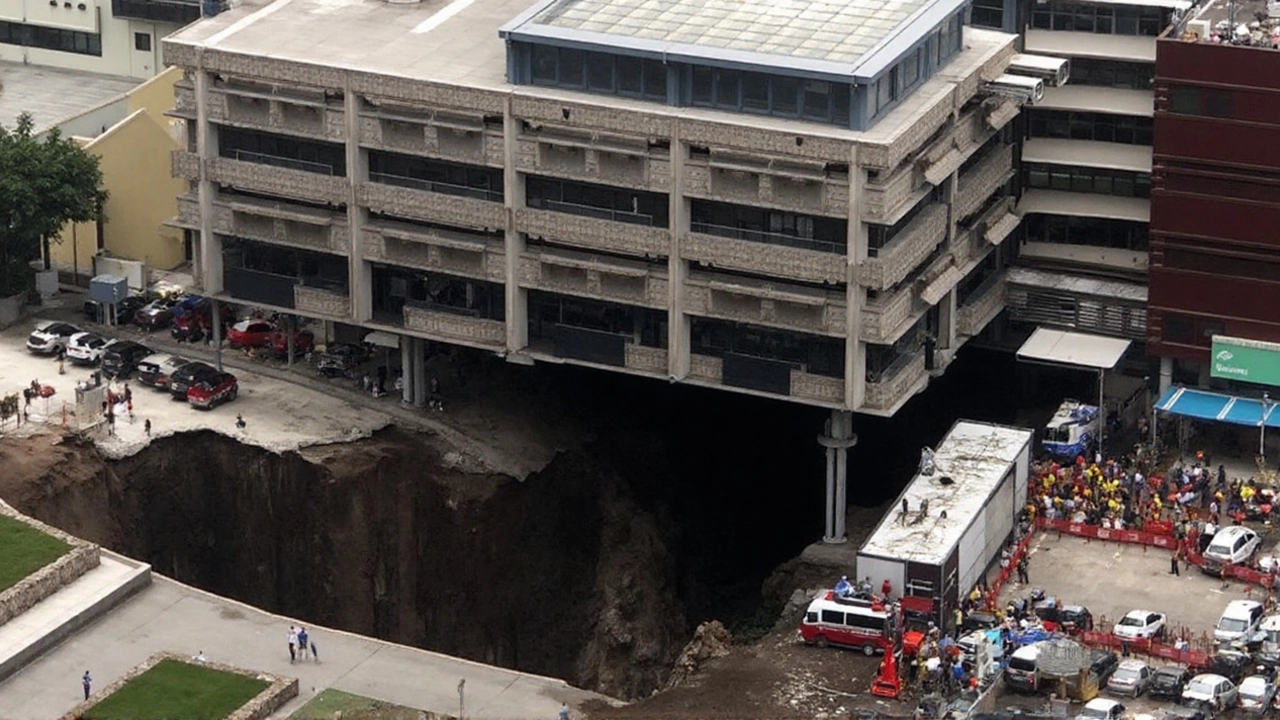What Happened
At about 7:15 a.m. on September 24, 2025, a massive hole erupted on Samsen Road in Bangkok’s historic Dusit district. The sinkhole measured roughly 50 meters deep and covered an area of 900 square meters, instantly swallowing parked cars, a traffic light, and several electricity poles.
Witnesses say the ground gave way with a loud rumble, and a plume of dust rose as the earth collapsed into a void that appeared to be part of a larger underground network. Within minutes, emergency crews arrived, barricading the site and cutting power and water to prevent further hazards.
Bangkok Governor Chadchart Sittipunt, an engineer by training, rushed to the scene and confirmed that the sinkhole was the direct result of a tunnel collapse linked to the ongoing Mass Rapid Transit (MRT) expansion. "The land slipped into the tunnel joint between the dual‑track line and the new station. The tunnel gave way, the pipe burst, and water rushed in, pulling everything down," he explained in a video posted to his official account.
Prime Minister Anutin Charnvirakul later emphasized that, despite the dramatic scene, there were no reported injuries. The rapid response by police, fire services, and the hospital’s own emergency team kept the situation from turning deadly.

Response and Aftermath
Vajira Hospital, a major public medical center located minutes from the breach, announced an immediate suspension of new admissions as a precaution. While the hospital’s core facilities remained intact, officials feared that the unstable ground could threaten the building’s structural integrity if the hole widened.
Nearby structures, including a police station and several apartment blocks, were deemed unsafe and evacuated. Residents were escorted to temporary shelters, and utility crews shut off electricity and water lines to avoid electrocution or further flooding.
The sinkhole also unleashed a torrent of water from the ruptured pipe, creating a rapid flow that threatened to erode the surrounding soil. Engineers on site began installing shoring beams and pumping out water to stabilize the cavity. Their top priority, as Governor Sittipunt stressed, is to plug the hole before the next rainstorm lands, because heavy rain could accelerate the collapse and pull more buildings into the void.
City officials have launched an independent investigation into the MRT construction practices that led to the disaster. Early findings suggest that inadequate joint reinforcement and a possible shift in the underlying soil composition may have played a role. The incident has revived public concerns about Bangkok’s aggressive push to expand its underground transit network in a densely built environment.
Local businesses reported significant losses as the road closure forced traffic to detour through side streets, resulting in longer travel times and a slowdown in deliveries. Taxi drivers and ride‑share services posted on social media about the inconvenience, while commuters expressed frustration over the unpredictable nature of such infrastructure failures.
Authorities have promised to conduct a thorough safety audit of all active subway projects. In the meantime, the Department of Public Works has deployed additional monitoring equipment around the affected area to detect any further ground movement.
While the immediate danger appears contained, the long‑term impact on public confidence in Bangkok’s urban planning remains uncertain. Residents and experts alike are calling for stricter oversight, more transparent reporting on construction risks, and a reassessment of how quickly new underground lines are approved.
The sinkhole serves as a stark reminder that rapid development must be balanced with rigorous engineering checks, especially in a city where the ground is already stressed by a maze of existing tunnels, utilities, and high‑rise structures. The ongoing stabilization effort continues around the clock, with engineers working to seal the breach and prevent another episode of this magnitude.
The incident has also sparked a broader conversation about emergency preparedness in Thailand’s urban centers. Emergency responders praised the swift evacuation procedures but noted that clearer protocols for large‑scale underground failures could save even more lives in future emergencies.
As the city works to repair the damage, the Bangkok sinkhole stands as a cautionary tale for planners worldwide: when you dig deep beneath a megacity, every joint, pipe, and slab must be scrutinized, because the ground below can be just as unforgiving as any storm above.





